Childcare Assessment: Comprehensive Analysis of Child Development
VerifiedAdded on 2023/06/18
|18
|3782
|456
Report
AI Summary
This report provides a comprehensive childcare assessment focused on understanding and managing child behavior. It includes detailed event samples using the A-B-C (Antecedent-Behavior-Consequence) model to analyze specific incidents involving children named Lucy and Harri. The assessments cover various scenarios such as separation anxiety, toy disputes, food refusal, seeking attention, and jealousy. The report identifies triggers, analyzes emotional responses, and evaluates the appropriateness of behaviors within the children's developmental stages. Furthermore, it proposes strategies for childcare centers to address challenging behaviors, monitor the effectiveness of interventions, and adapt support levels based on the child's response. The overall aim is to provide insights and practical guidance for fostering positive behavior and supporting the emotional well-being of children in childcare settings. Desklib provides this document and many other solved assignments for students' reference.
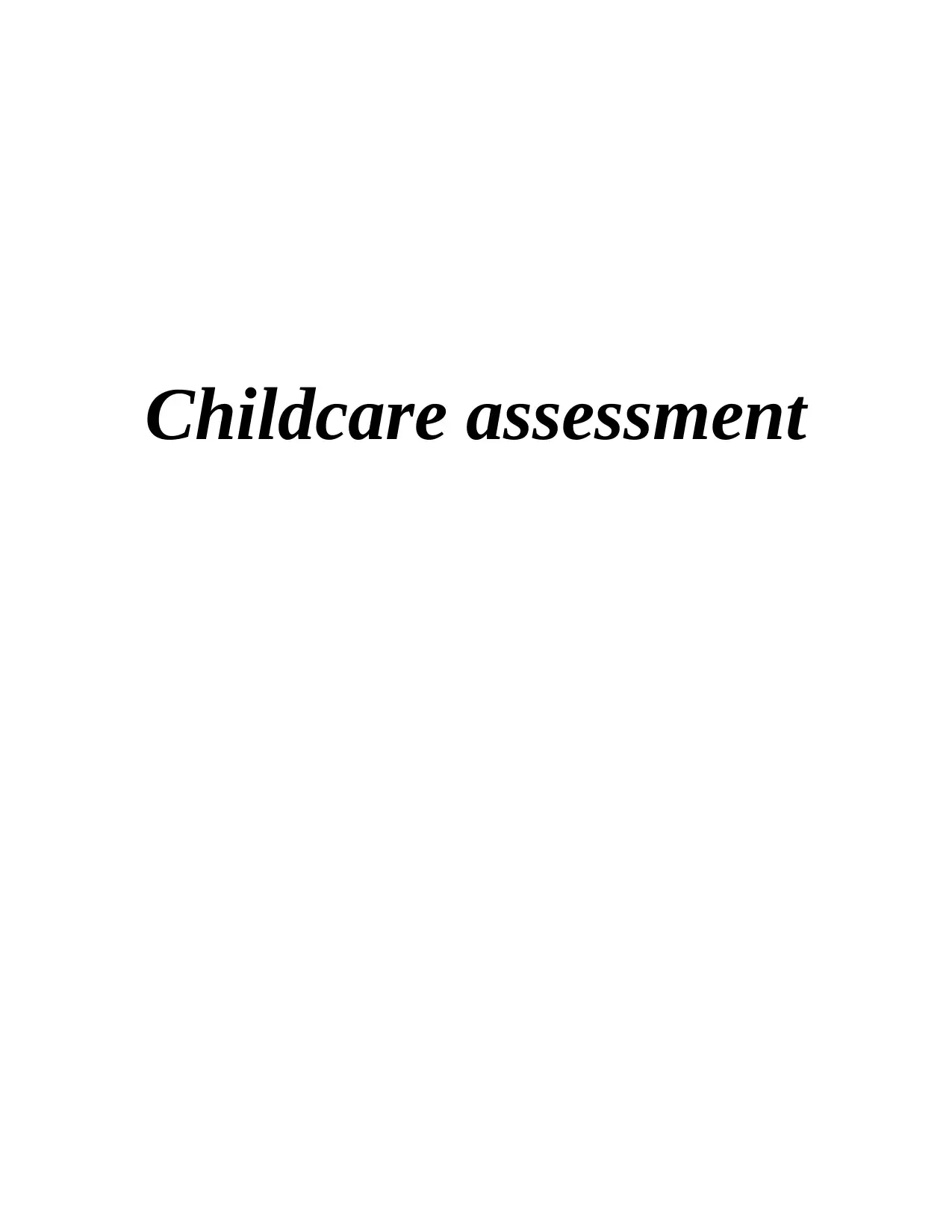
Childcare assessment
Paraphrase This Document
Need a fresh take? Get an instant paraphrase of this document with our AI Paraphraser
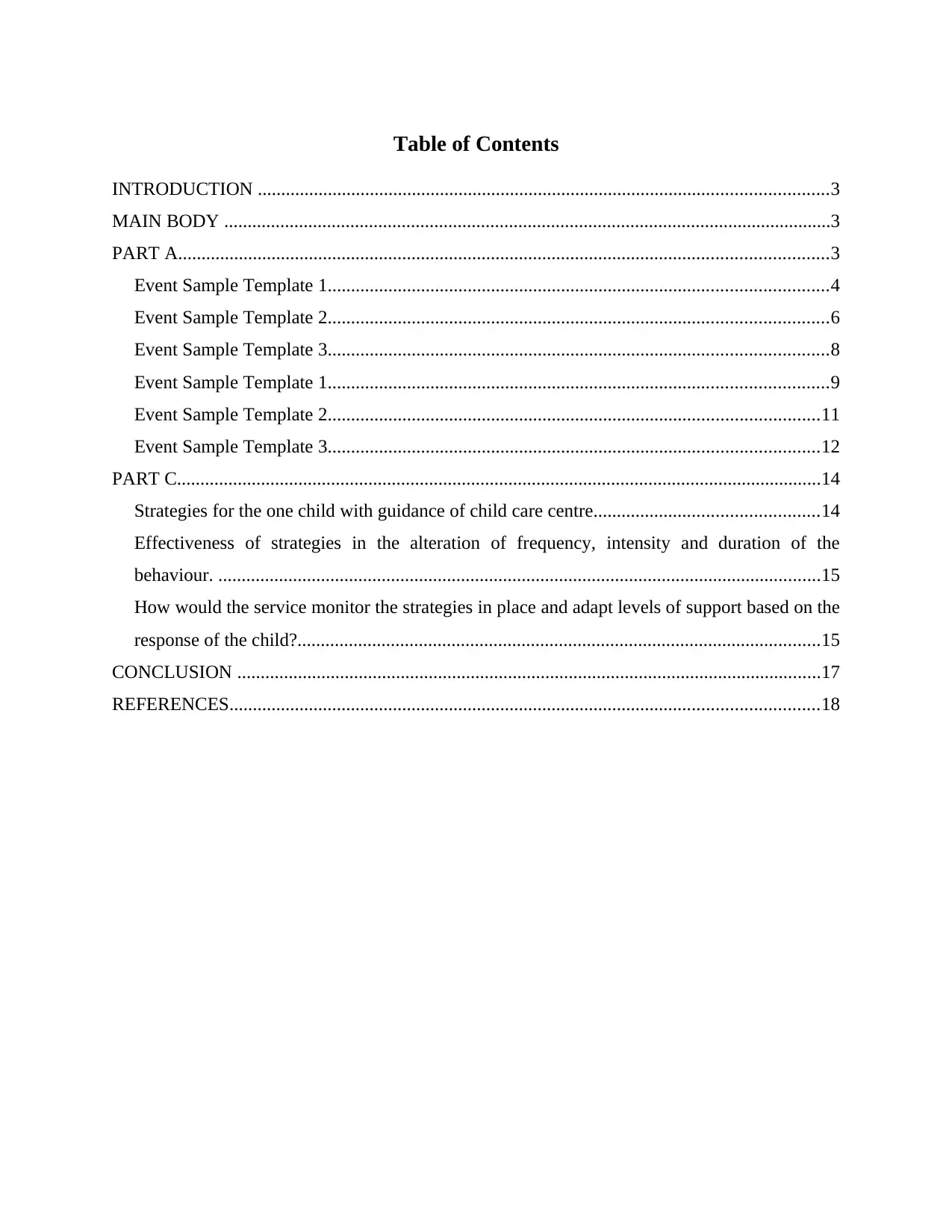
Table of Contents
INTRODUCTION ..........................................................................................................................3
MAIN BODY ..................................................................................................................................3
PART A...........................................................................................................................................3
Event Sample Template 1...........................................................................................................4
Event Sample Template 2...........................................................................................................6
Event Sample Template 3...........................................................................................................8
Event Sample Template 1...........................................................................................................9
Event Sample Template 2.........................................................................................................11
Event Sample Template 3.........................................................................................................12
PART C..........................................................................................................................................14
Strategies for the one child with guidance of child care centre................................................14
Effectiveness of strategies in the alteration of frequency, intensity and duration of the
behaviour. .................................................................................................................................15
How would the service monitor the strategies in place and adapt levels of support based on the
response of the child?................................................................................................................15
CONCLUSION .............................................................................................................................17
REFERENCES..............................................................................................................................18
INTRODUCTION ..........................................................................................................................3
MAIN BODY ..................................................................................................................................3
PART A...........................................................................................................................................3
Event Sample Template 1...........................................................................................................4
Event Sample Template 2...........................................................................................................6
Event Sample Template 3...........................................................................................................8
Event Sample Template 1...........................................................................................................9
Event Sample Template 2.........................................................................................................11
Event Sample Template 3.........................................................................................................12
PART C..........................................................................................................................................14
Strategies for the one child with guidance of child care centre................................................14
Effectiveness of strategies in the alteration of frequency, intensity and duration of the
behaviour. .................................................................................................................................15
How would the service monitor the strategies in place and adapt levels of support based on the
response of the child?................................................................................................................15
CONCLUSION .............................................................................................................................17
REFERENCES..............................................................................................................................18

INTRODUCTION
The behaviour is defined as the how a child used to start their behaviour towards their
learn action, reaction and functioning which may be monitor and used to learn from the various
assessment of the environment and situation which they observe by the nearby. In this, the
challenges are used to analyse which show the challenging approach which is associated with the
term behaviour that describe the interfere with the child daily life. In this, the child in their early
age is usually believed in curiosity, they are easily distracted show the keen of independence and
still developing self regulation. In the development of child the early child care centre used to
play role in learning and getting along with and following rules. In this report, the development
of child and their role is well analysed by the some of the case which show the various
assessment and responsibility of the child care centre.
MAIN BODY
PART A
The behaviour is defined as the how a child used to start their behaviour towards their
learn action, reaction and functioning which may be monitor and used to learn from the various
assessment of the environment and situation which they observe by the nearby. In this, the
challenges are used to analyse which show the challenging approach which is associated with the
term behaviour that describe the interfere with the child daily life. In this, the child in their early
age is usually believed in curiosity, they are easily distracted show the keen of independence and
still developing self regulation. In the development of child the early child care centre used to
play role in learning and getting along with and following rules. In this report, the development
of child and their role is well analysed by the some of the case which show the various
assessment and responsibility of the child care centre.
MAIN BODY
PART A
⊘ This is a preview!⊘
Do you want full access?
Subscribe today to unlock all pages.

Trusted by 1+ million students worldwide
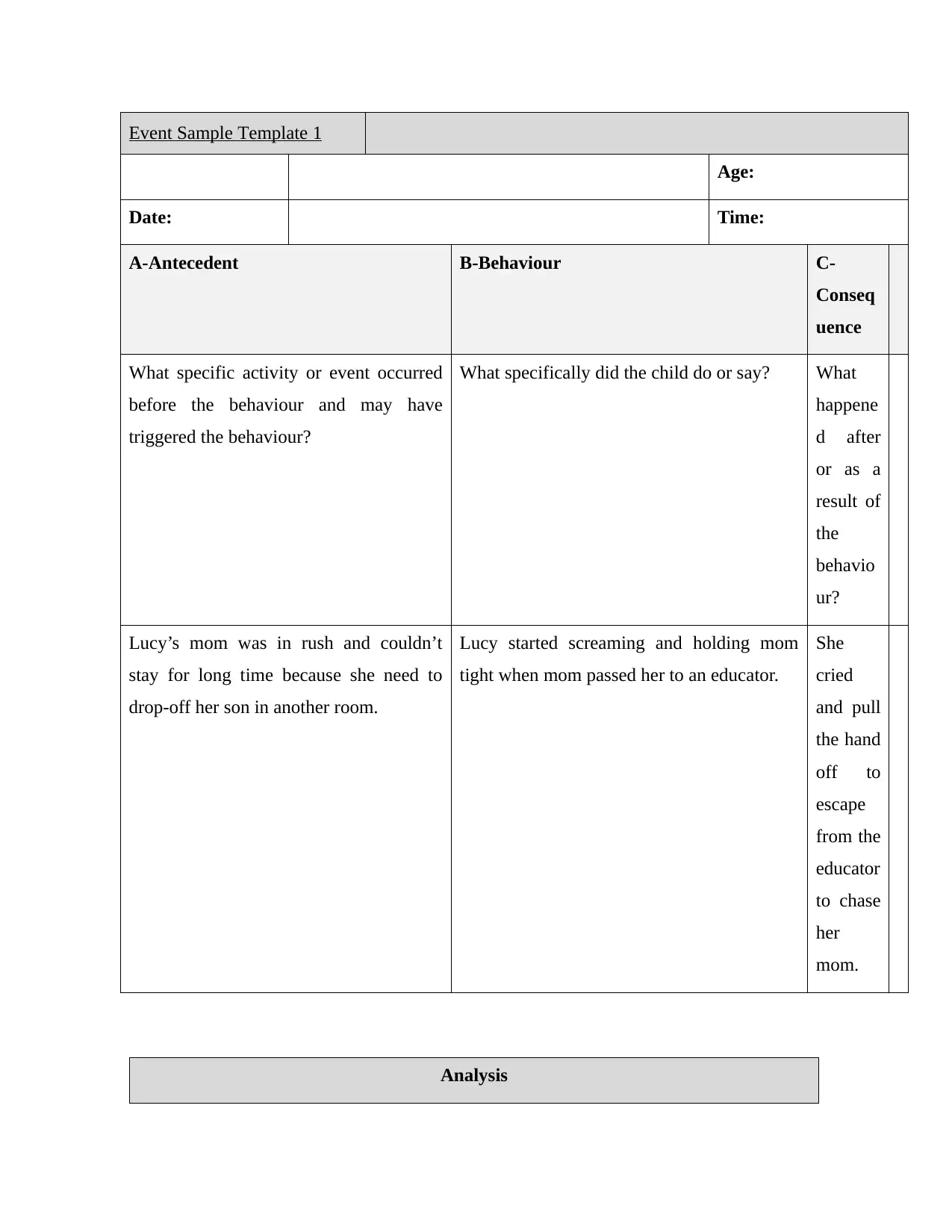
Event Sample Template 1
Age:
Date: Time:
A-Antecedent B-Behaviour C-
Conseq
uence
What specific activity or event occurred
before the behaviour and may have
triggered the behaviour?
What specifically did the child do or say? What
happene
d after
or as a
result of
the
behavio
ur?
Lucy’s mom was in rush and couldn’t
stay for long time because she need to
drop-off her son in another room.
Lucy started screaming and holding mom
tight when mom passed her to an educator.
She
cried
and pull
the hand
off to
escape
from the
educator
to chase
her
mom.
Analysis
Age:
Date: Time:
A-Antecedent B-Behaviour C-
Conseq
uence
What specific activity or event occurred
before the behaviour and may have
triggered the behaviour?
What specifically did the child do or say? What
happene
d after
or as a
result of
the
behavio
ur?
Lucy’s mom was in rush and couldn’t
stay for long time because she need to
drop-off her son in another room.
Lucy started screaming and holding mom
tight when mom passed her to an educator.
She
cried
and pull
the hand
off to
escape
from the
educator
to chase
her
mom.
Analysis
Paraphrase This Document
Need a fresh take? Get an instant paraphrase of this document with our AI Paraphraser

What were the antecedents? Were there any triggers identified? What was the behaviour
of concern and is this behaviour identified as being within the norms for a child of this
age/stage of development? How did the consequence/result of this behaviour contribute
to the behaviour either continuing or improving/decreasing over time? What emotions
were displayed by the child? Comment on the child’s social skills and strategies used to
deal with these consequences.
Lucy said she wanted her mom stay with her but mom was busy to drop off
another child .
Behaviour displayed: screaming, crying, holding mom tight, pull the hand off.
Emotions displayed: angry, upset because of separation anxiety.
Lucy is in the toddler age group and sometimes she still needs the security of her
parents. In such a case, an educator should calm her down by telling her that “I
know that you’re sad because mom cannot able to stay with you for a while. Mom
is very busy today, but she will go back to pick up you soon when she finished her
work. Could we go around, finding a book that you love, and I’ll read for you? Or
what would you like to do now?”
of concern and is this behaviour identified as being within the norms for a child of this
age/stage of development? How did the consequence/result of this behaviour contribute
to the behaviour either continuing or improving/decreasing over time? What emotions
were displayed by the child? Comment on the child’s social skills and strategies used to
deal with these consequences.
Lucy said she wanted her mom stay with her but mom was busy to drop off
another child .
Behaviour displayed: screaming, crying, holding mom tight, pull the hand off.
Emotions displayed: angry, upset because of separation anxiety.
Lucy is in the toddler age group and sometimes she still needs the security of her
parents. In such a case, an educator should calm her down by telling her that “I
know that you’re sad because mom cannot able to stay with you for a while. Mom
is very busy today, but she will go back to pick up you soon when she finished her
work. Could we go around, finding a book that you love, and I’ll read for you? Or
what would you like to do now?”

Event Sample Template 2
Child’s Name: Lucy Age:
Date: Time:
A-Antecedent B-Behaviour C-
Conseq
uence
What specific activity or event occurred
before the behaviour and may have
triggered the behaviour?
What specifically did the child do or say? What
happene
d after
or as a
result of
the
behavio
ur?
Lucy and her friend were playing the trucks
together, a friend took Lucy’s truck and run
away.
Lucy screamed, chased and hitted him. She
said: “it’s mine”, then she snatched a truck
back.
Lucy
went
inside
the
room to
play,
during
her
friend
walked
away
and
played
with
another
Child’s Name: Lucy Age:
Date: Time:
A-Antecedent B-Behaviour C-
Conseq
uence
What specific activity or event occurred
before the behaviour and may have
triggered the behaviour?
What specifically did the child do or say? What
happene
d after
or as a
result of
the
behavio
ur?
Lucy and her friend were playing the trucks
together, a friend took Lucy’s truck and run
away.
Lucy screamed, chased and hitted him. She
said: “it’s mine”, then she snatched a truck
back.
Lucy
went
inside
the
room to
play,
during
her
friend
walked
away
and
played
with
another
⊘ This is a preview!⊘
Do you want full access?
Subscribe today to unlock all pages.

Trusted by 1+ million students worldwide

friends.
Analysis
What were the antecedents? Were there any triggers identified? What was the
behaviour of concern and is this behaviour identified as being within the norms for a
child of this age/stage of development? How did the consequence/result of this
behaviour contribute to the behaviour either continuing or improving/decreasing over
time? What emotions were displayed by the child? Comment on the child’s social
skills and strategies used to deal with these consequences.
Lucy play the toys with friend, then her friend took her toy and run away.
Behaviour displayed: screamed, chased, hitted, snatched.
Emotions displayed: angry.
This is completely normal behavior for children from 2-3 years old .In such a
case, an educator should taught Lucy and her friend that other children have
feelings, too. We need to share the toys or we can take turn, then we can play
together.
Analysis
What were the antecedents? Were there any triggers identified? What was the
behaviour of concern and is this behaviour identified as being within the norms for a
child of this age/stage of development? How did the consequence/result of this
behaviour contribute to the behaviour either continuing or improving/decreasing over
time? What emotions were displayed by the child? Comment on the child’s social
skills and strategies used to deal with these consequences.
Lucy play the toys with friend, then her friend took her toy and run away.
Behaviour displayed: screamed, chased, hitted, snatched.
Emotions displayed: angry.
This is completely normal behavior for children from 2-3 years old .In such a
case, an educator should taught Lucy and her friend that other children have
feelings, too. We need to share the toys or we can take turn, then we can play
together.
Paraphrase This Document
Need a fresh take? Get an instant paraphrase of this document with our AI Paraphraser
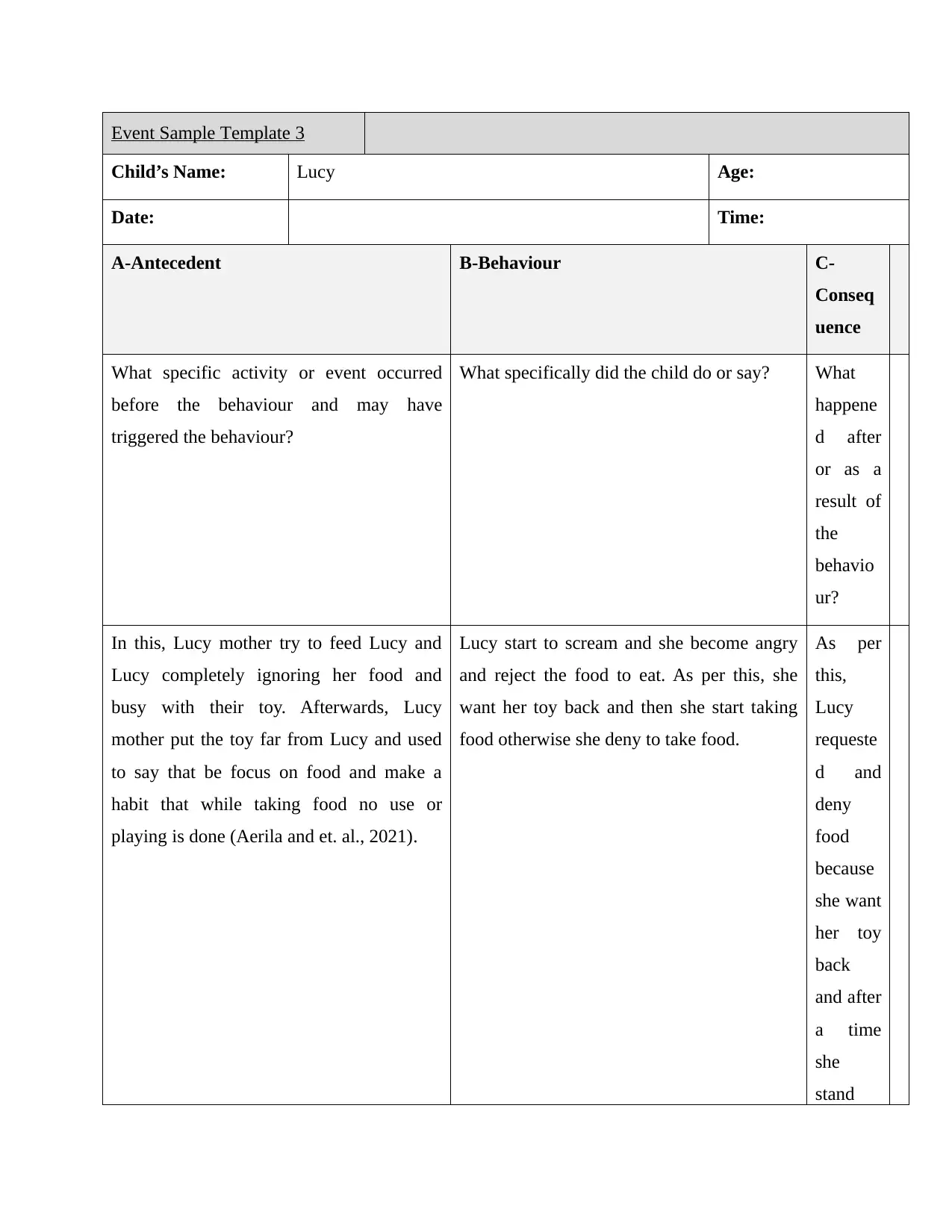
Event Sample Template 3
Child’s Name: Lucy Age:
Date: Time:
A-Antecedent B-Behaviour C-
Conseq
uence
What specific activity or event occurred
before the behaviour and may have
triggered the behaviour?
What specifically did the child do or say? What
happene
d after
or as a
result of
the
behavio
ur?
In this, Lucy mother try to feed Lucy and
Lucy completely ignoring her food and
busy with their toy. Afterwards, Lucy
mother put the toy far from Lucy and used
to say that be focus on food and make a
habit that while taking food no use or
playing is done (Aerila and et. al., 2021).
Lucy start to scream and she become angry
and reject the food to eat. As per this, she
want her toy back and then she start taking
food otherwise she deny to take food.
As per
this,
Lucy
requeste
d and
deny
food
because
she want
her toy
back
and after
a time
she
stand
Child’s Name: Lucy Age:
Date: Time:
A-Antecedent B-Behaviour C-
Conseq
uence
What specific activity or event occurred
before the behaviour and may have
triggered the behaviour?
What specifically did the child do or say? What
happene
d after
or as a
result of
the
behavio
ur?
In this, Lucy mother try to feed Lucy and
Lucy completely ignoring her food and
busy with their toy. Afterwards, Lucy
mother put the toy far from Lucy and used
to say that be focus on food and make a
habit that while taking food no use or
playing is done (Aerila and et. al., 2021).
Lucy start to scream and she become angry
and reject the food to eat. As per this, she
want her toy back and then she start taking
food otherwise she deny to take food.
As per
this,
Lucy
requeste
d and
deny
food
because
she want
her toy
back
and after
a time
she
stand
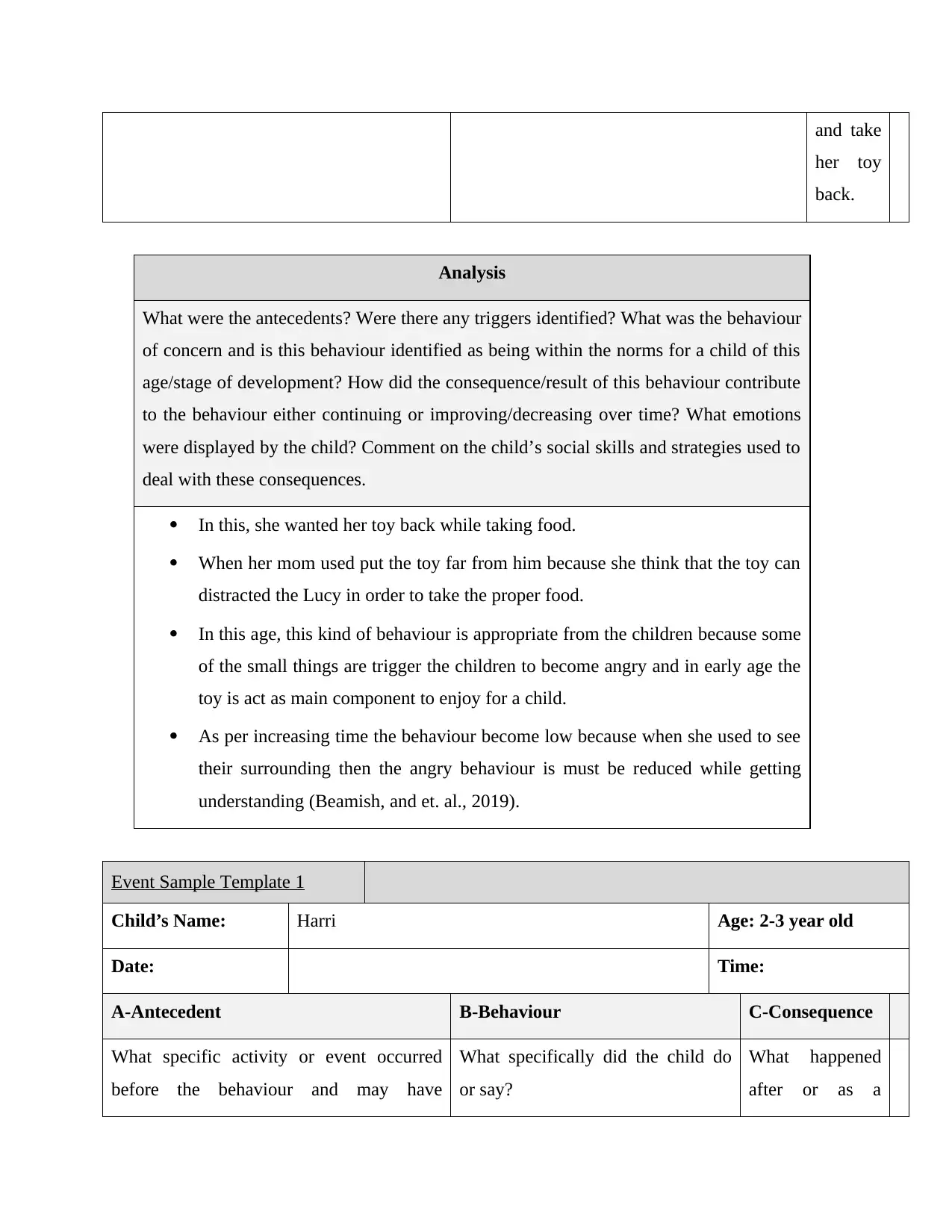
and take
her toy
back.
Analysis
What were the antecedents? Were there any triggers identified? What was the behaviour
of concern and is this behaviour identified as being within the norms for a child of this
age/stage of development? How did the consequence/result of this behaviour contribute
to the behaviour either continuing or improving/decreasing over time? What emotions
were displayed by the child? Comment on the child’s social skills and strategies used to
deal with these consequences.
In this, she wanted her toy back while taking food.
When her mom used put the toy far from him because she think that the toy can
distracted the Lucy in order to take the proper food.
In this age, this kind of behaviour is appropriate from the children because some
of the small things are trigger the children to become angry and in early age the
toy is act as main component to enjoy for a child.
As per increasing time the behaviour become low because when she used to see
their surrounding then the angry behaviour is must be reduced while getting
understanding (Beamish, and et. al., 2019).
Event Sample Template 1
Child’s Name: Harri Age: 2-3 year old
Date: Time:
A-Antecedent B-Behaviour C-Consequence
What specific activity or event occurred
before the behaviour and may have
What specifically did the child do
or say?
What happened
after or as a
her toy
back.
Analysis
What were the antecedents? Were there any triggers identified? What was the behaviour
of concern and is this behaviour identified as being within the norms for a child of this
age/stage of development? How did the consequence/result of this behaviour contribute
to the behaviour either continuing or improving/decreasing over time? What emotions
were displayed by the child? Comment on the child’s social skills and strategies used to
deal with these consequences.
In this, she wanted her toy back while taking food.
When her mom used put the toy far from him because she think that the toy can
distracted the Lucy in order to take the proper food.
In this age, this kind of behaviour is appropriate from the children because some
of the small things are trigger the children to become angry and in early age the
toy is act as main component to enjoy for a child.
As per increasing time the behaviour become low because when she used to see
their surrounding then the angry behaviour is must be reduced while getting
understanding (Beamish, and et. al., 2019).
Event Sample Template 1
Child’s Name: Harri Age: 2-3 year old
Date: Time:
A-Antecedent B-Behaviour C-Consequence
What specific activity or event occurred
before the behaviour and may have
What specifically did the child do
or say?
What happened
after or as a
⊘ This is a preview!⊘
Do you want full access?
Subscribe today to unlock all pages.

Trusted by 1+ million students worldwide
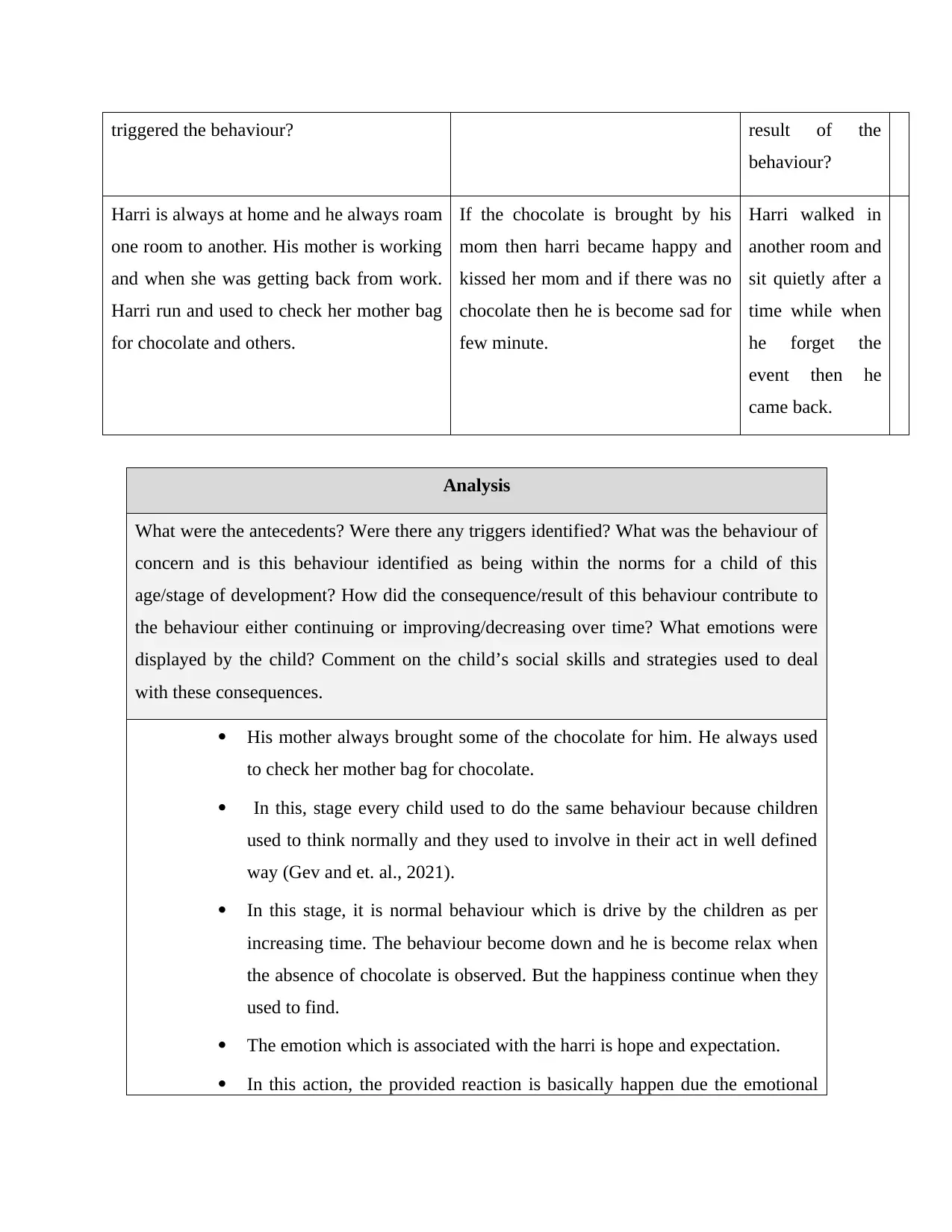
triggered the behaviour? result of the
behaviour?
Harri is always at home and he always roam
one room to another. His mother is working
and when she was getting back from work.
Harri run and used to check her mother bag
for chocolate and others.
If the chocolate is brought by his
mom then harri became happy and
kissed her mom and if there was no
chocolate then he is become sad for
few minute.
Harri walked in
another room and
sit quietly after a
time while when
he forget the
event then he
came back.
Analysis
What were the antecedents? Were there any triggers identified? What was the behaviour of
concern and is this behaviour identified as being within the norms for a child of this
age/stage of development? How did the consequence/result of this behaviour contribute to
the behaviour either continuing or improving/decreasing over time? What emotions were
displayed by the child? Comment on the child’s social skills and strategies used to deal
with these consequences.
His mother always brought some of the chocolate for him. He always used
to check her mother bag for chocolate.
In this, stage every child used to do the same behaviour because children
used to think normally and they used to involve in their act in well defined
way (Gev and et. al., 2021).
In this stage, it is normal behaviour which is drive by the children as per
increasing time. The behaviour become down and he is become relax when
the absence of chocolate is observed. But the happiness continue when they
used to find.
The emotion which is associated with the harri is hope and expectation.
In this action, the provided reaction is basically happen due the emotional
behaviour?
Harri is always at home and he always roam
one room to another. His mother is working
and when she was getting back from work.
Harri run and used to check her mother bag
for chocolate and others.
If the chocolate is brought by his
mom then harri became happy and
kissed her mom and if there was no
chocolate then he is become sad for
few minute.
Harri walked in
another room and
sit quietly after a
time while when
he forget the
event then he
came back.
Analysis
What were the antecedents? Were there any triggers identified? What was the behaviour of
concern and is this behaviour identified as being within the norms for a child of this
age/stage of development? How did the consequence/result of this behaviour contribute to
the behaviour either continuing or improving/decreasing over time? What emotions were
displayed by the child? Comment on the child’s social skills and strategies used to deal
with these consequences.
His mother always brought some of the chocolate for him. He always used
to check her mother bag for chocolate.
In this, stage every child used to do the same behaviour because children
used to think normally and they used to involve in their act in well defined
way (Gev and et. al., 2021).
In this stage, it is normal behaviour which is drive by the children as per
increasing time. The behaviour become down and he is become relax when
the absence of chocolate is observed. But the happiness continue when they
used to find.
The emotion which is associated with the harri is hope and expectation.
In this action, the provided reaction is basically happen due the emotional
Paraphrase This Document
Need a fresh take? Get an instant paraphrase of this document with our AI Paraphraser

aspect which can not figure within some of the minute, with the time, the
reaction become normal.
Event Sample Template 2
Child’s Name: Harri Age:
Date: Time:
A-Antecedent B-Behaviour C-Consequence
What specific activity or event
occurred before the behaviour and may
have triggered the behaviour?
What specifically did the child do or
say?
What happened
after or as a
result of the
behaviour?
In this, Harri was single child of her
mother, but they have other sibling. As
per this, when sibling are arrive at
home and harri mother used to focus on
sibling. Harri get jealous and he used to
hold her mother hand (Jones and et. al.,
2020).
In this, harri get jealous from
sibling because her mother give
more attention to them.
Harri used to
hold her mother
hand and follow
her mother.
Analysis
What were the antecedents? Were there any triggers identified? What was the behaviour
of concern and is this behaviour identified as being within the norms for a child of this
age/stage of development? How did the consequence/result of this behaviour contribute
to the behaviour either continuing or improving/decreasing over time? What emotions
were displayed by the child? Comment on the child’s social skills and strategies used to
deal with these consequences.
Harri notice that the her mother provide more attention to their sibling.
reaction become normal.
Event Sample Template 2
Child’s Name: Harri Age:
Date: Time:
A-Antecedent B-Behaviour C-Consequence
What specific activity or event
occurred before the behaviour and may
have triggered the behaviour?
What specifically did the child do or
say?
What happened
after or as a
result of the
behaviour?
In this, Harri was single child of her
mother, but they have other sibling. As
per this, when sibling are arrive at
home and harri mother used to focus on
sibling. Harri get jealous and he used to
hold her mother hand (Jones and et. al.,
2020).
In this, harri get jealous from
sibling because her mother give
more attention to them.
Harri used to
hold her mother
hand and follow
her mother.
Analysis
What were the antecedents? Were there any triggers identified? What was the behaviour
of concern and is this behaviour identified as being within the norms for a child of this
age/stage of development? How did the consequence/result of this behaviour contribute
to the behaviour either continuing or improving/decreasing over time? What emotions
were displayed by the child? Comment on the child’s social skills and strategies used to
deal with these consequences.
Harri notice that the her mother provide more attention to their sibling.

When harri mother used to provide more attention to sibling this will
create jealousy.
At this stage, it is well identified that the condition which is associated
with the harri response is usual because at this age this is normal
behaviour which is usually happen and noticed by the children.
This is permanent feeling in the age of initial and after a time while it
become in the phase of normal behaviour but the emotions are always
present in the children (Kahn, and et. al., 2019).
The emotion is natural which is acted during this stage which is
associated with the jealousy.
After a time while when the child know the feeling and social behaviour
of love, then he used to identified that the feeling and love is permanent.
Event Sample Template 3
Child’s Name: Harri Age:
Date: Time:
A-Antecedent B-Behaviour C-Consequence
What specific activity or event occurred
before the behaviour and may have
triggered the behaviour?
What specifically did the child do
or say?
What happened
after or as a
result of the
behaviour?
Harri used to explore market with her mom
and suddenly he likes a toy and he
demanded the toy from her mom. Mom
deny to purchase by saying you have
sufficient toy.
In this, Harri used to become sad
and do not expect anything from his
mom. When she offers to eat
something. Harri show his anger by
refusing to eat.
The anger and
sadness are used
to collected
inside the harri.
He quit and do
not talk to her
mother and
create jealousy.
At this stage, it is well identified that the condition which is associated
with the harri response is usual because at this age this is normal
behaviour which is usually happen and noticed by the children.
This is permanent feeling in the age of initial and after a time while it
become in the phase of normal behaviour but the emotions are always
present in the children (Kahn, and et. al., 2019).
The emotion is natural which is acted during this stage which is
associated with the jealousy.
After a time while when the child know the feeling and social behaviour
of love, then he used to identified that the feeling and love is permanent.
Event Sample Template 3
Child’s Name: Harri Age:
Date: Time:
A-Antecedent B-Behaviour C-Consequence
What specific activity or event occurred
before the behaviour and may have
triggered the behaviour?
What specifically did the child do
or say?
What happened
after or as a
result of the
behaviour?
Harri used to explore market with her mom
and suddenly he likes a toy and he
demanded the toy from her mom. Mom
deny to purchase by saying you have
sufficient toy.
In this, Harri used to become sad
and do not expect anything from his
mom. When she offers to eat
something. Harri show his anger by
refusing to eat.
The anger and
sadness are used
to collected
inside the harri.
He quit and do
not talk to her
mother and
⊘ This is a preview!⊘
Do you want full access?
Subscribe today to unlock all pages.

Trusted by 1+ million students worldwide
1 out of 18
Your All-in-One AI-Powered Toolkit for Academic Success.
+13062052269
info@desklib.com
Available 24*7 on WhatsApp / Email
![[object Object]](/_next/static/media/star-bottom.7253800d.svg)
Unlock your academic potential
Copyright © 2020–2025 A2Z Services. All Rights Reserved. Developed and managed by ZUCOL.

